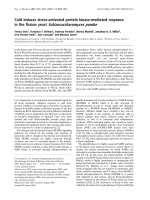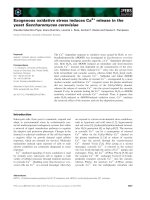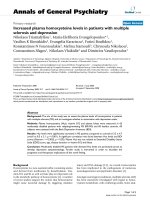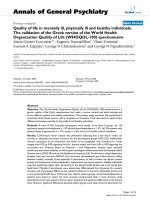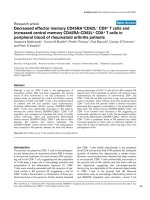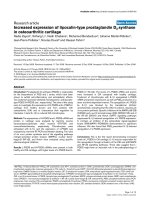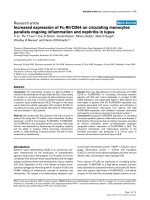Báo cáo y học: " Increased oxidative stress in asymptomatic current chronic smokers and GOLD stage 0 COPD" docx
Bạn đang xem bản rút gọn của tài liệu. Xem và tải ngay bản đầy đủ của tài liệu tại đây (850.14 KB, 10 trang )
BioMed Central
Page 1 of 10
(page number not for citation purposes)
Respiratory Research
Open Access
Research
Increased oxidative stress in asymptomatic current chronic
smokers and GOLD stage 0 COPD
Paula Rytilä
1
, Tiina Rehn
2
, Helen Ilumets
2
, Annamari Rouhos
2
,
Anssi Sovijärvi
3
, Marjukka Myllärniemi
2
and Vuokko L Kinnula*
4
Address:
1
Division of Allergology, Helsinki University Central Hospital, Helsinki, Finland,
2
Pulmonary Medicine, Helsinki University Central
Hospital, Helsinki, Finland,
3
Clinical Physiology, Helsinki University Central Hospital, Helsinki, Finland and
4
Department of Medicine,
University of Helsinki, Helsinki, Finland
Email: Paula Rytilä - ; Tiina Rehn - ; Helen Ilumets - ;
Annamari Rouhos - ; Anssi Sovijärvi - ; Marjukka Myllärniemi - ;
Vuokko L Kinnula* -
* Corresponding author
Abstract
Background: Chronic obstructive pulmonary disease (COPD) is associated with increased
oxidative and nitrosative stress. The aim of our study was to assess the importance of these factors
in the airways of healthy smokers and symptomatic smokers without airway obstruction, i.e.
individuals with GOLD stage 0 COPD.
Methods: Exhaled NO (FENO) and induced sputum samples were collected from 22 current
smokers (13 healthy smokers without any respiratory symptoms and 9 with symptoms i.e. stage 0
COPD) and 22 healthy age-matched non-smokers (11 never smokers and 11 ex-smokers). Sputum
cell differential counts, and expressions of inducible nitric oxide synthase (iNOS), myeloperoxidase
(MPO), nitrotyrosine and 4-hydroxy-2-nonenal (4-HNE) were analysed from cytospins by
immunocytochemistry. Eosinophil cationic protein (ECP) and lactoferrin were measured from
sputum supernatants by ELISA.
Results: FENO was significantly decreased in smokers, mean (SD) 11.0 (6.7) ppb, compared to
non-smokers, 22.9 (10.0), p < 0.0001. Induced sputum showed increased levels of neutrophils (p =
0.01) and elevated numbers of iNOS (p = 0.004), MPO (p = 0.003), nitrotyrosine (p = 0.003), and
4-HNE (p = 0.03) positive cells in smokers when compared to non-smokers. Sputum lactoferrin
levels were also higher in smokers than in non-smokers (p = 0.02). Furthermore, we noted four
negative correlations between FENO and 1) total neutrophils (r = -0.367, p = 0.02), 2) positive cells
for iNOS (r = -0.503, p = 0.005), 3) MPO (r = -0.547, p = 0.008), and 4) nitrotyrosine (r = -0.424,
p = 0.03). However, no major differences were found between never smokers and ex-smokers or
between healthy smokers and stage 0 COPD patients.
Conclusion: Our results clearly indicate that several markers of oxidative/nitrosative stress are
increased in current cigarette smokers compared to non-smokers and no major differences can be
observed in these biomarkers between non-symptomatic smokers and subjects with GOLD stage
0 COPD.
Published: 28 April 2006
Respiratory Research 2006, 7:69 doi:10.1186/1465-9921-7-69
Received: 03 November 2005
Accepted: 28 April 2006
This article is available from: />© 2006 Rytilä et al; licensee BioMed Central Ltd.
This is an Open Access article distributed under the terms of the Creative Commons Attribution License ( />),
which permits unrestricted use, distribution, and reproduction in any medium, provided the original work is properly cited.
Respiratory Research 2006, 7:69 />Page 2 of 10
(page number not for citation purposes)
Introduction
The most important factor causing chronic obstructive
pulmonary disease (COPD) is cigarette smoking which
causes increased oxidative and nitrosative stress in this
disease [1-3]. One major contributor to the increased oxi-
dant burden in COPD is evidently nitric oxide (NO) since
cigarette smoke contains the highest levels of NO to
which humans are directly exposed [3]. Inducible nitric
oxide synthase (iNOS), enzyme that produces the highest
levels of NO in human cells and tissues, is also signifi-
cantly induced by many of the mediators present in air-
way inflammation [1]. Markers of oxidative/nitrosative
stress have been detected in the sputum and lung speci-
mens of COPD [4-8]., but it is still unclear to what extent
these markers can differentiate healthy smokers from
non-smokers or smokers with symptoms but normal lung
function parameters (FEV/FVC>70) from non-sympto-
matic smokers.
One of the most widely investigated non-invasive markers
of nitrosative stress and airway inflammation is fractional
exhaled NO (FENO). It is a sensitive and specific marker
for eosinophilic inflammation in non-smokers [9], but its
significance in smokers and its association with other
markers of oxidative/nitrosative stress in the lung are
poorly understood. FENO is significantly decreased in
chronic smokers while it is variable in COPD [10-14].
There is evidence that FENO is higher in ex-smokers with
COPD than in healthy non-smokers or current smokers
with COPD [14], higher in COPD than in smokers with
chronic bronchitis [15] and higher in COPD patients with
reversible airflow limitation than in those with no revers-
ibility [16]. Recent studies have indicated that FENO may
vary at different levels of the airways [17]. FENO can be
hypothesized to correlate with the numbers of eosi-
nophils also in smokers [9,16]., but its association with
neutrophil/macrophage associated airway inflammation
needs further investigations.
Oxidative/nitrosative stress in moderate-severe COPD
and its exacerbation has been confirmed by measuring the
level/activity of oxidant producing enzymes and via the
several "foot prints" of reactive oxygen species/reactive
nitrogen species (ROS/RNS) mediated markers e.g. nitro-
tyrosine, 4-hydroxy-2-nonenal (4-HNE), other markers of
lipid peroxidation, protein carbonyls and markers of DNA
damage [2,3,18,19]. The classification of COPD that was
launched in 2001 included a new group of subjects, those
that have symptoms but normal lung function parameters
(FEV/FVC>70) (GOLD stage 0 COPD) [20]. It is, however,
unclear whether chronic symptoms actually lead to subse-
quent airway obstruction [2,21,22]. It is also unknown
whether these above mentioned markers of oxidative/nit-
rosative stress can differentiate asymptomatic healthy
smokers from those who have stage 0 COPD.
Non-invasive methods such as exhaled air, exhaled breath
condensate and induced sputum have been widely used in
the indirect assessment of COPD and its progression
[14,23]. Of these techniques, exhaled air and induced
sputum are relatively well standardized while the exhaled
breath condensate, though promising, is still under evalu-
ation [24-27]. In the present study, FENO, the inflamma-
tory profile of the induced sputum, inducible nitric oxide
synthase (iNOS), myeloperoxidase (MPO), lactoferrin
(marker of neutrophils), eosinophil cationic protein
(ECP), nitrotyrosine and 4-HNE as markers of oxidative/
nitrosative damage of cellular proteins/lipids were inves-
tigated in 44 subjects, non-smokers or smokers. Smokers
were either totally symptom free or if symptomatic, they
were classified to have GOLD stage 0 COPD i.e. they had
normal lung function parameters [20]. The features that
might lead to difficulties in the interpretation of the find-
ings such as allergies and reversibility in the bronchodila-
tion test were excluded. In further analyses, the levels of
FENO were also correlated with the inflammatory profile
of the airways, and markers of oxidative/nitrosative stress.
Subjects and methods
Altogether 22 current smokers (13 healthy smokers with-
out any respiratory symptoms and 9 GOLD stage 0 COPD
patients with chronic symptoms (cough and sputum pro-
duction), mean smoking history 41 pack years) were
included. At least 12 hours had elapsed from the last cig-
arette. Symptoms were assessed with the St Georges Respi-
ratory Questionnaire, each symptomatic subject had both
cough and sputum production. Smokers had no airway
obstruction (postbronchodilator FEV1/FVC > 70%) and
no significant reversibility (less than 10% reversibility in
FEV1 after 400 µg of inhaled salbutamol). The control
group included 22 non-smokers (11 never smokers and
11 ex-smokers at least 20 years from quitting of smoking
and less than 15 pack years) with no history of lung dis-
ease. All the subjects participating in the study were non-
atopic with no history of allergy. None of the subjects had
suffered from respiratory infection for at least 8 weeks.
One smoker had been prescribed inhaled steroids and 2
were using a β
2
agonist as a relief medication. All other
subjects were unmedicated.
The Ethics Committee of Helsinki University Hospital
approved the study. All subjects gave full, informed con-
sent. The study was registered by the hospital http://
/clinicaltrials.
Lung function measurements
Flow-volume spirometry was performed with a flow-vol-
ume spirometer connected to a computer (Medikro PC
Spirometry, Medikro Oy, Kuopio, Finland) and Finnish
reference values were used [28]. The pulmonary diffusion
Respiratory Research 2006, 7:69 />Page 3 of 10
(page number not for citation purposes)
capacity for carbon monoxide (DLCO) and static lung
volumes were measured by single breath technique [28].
NO measurements
Exhaled NO (FENO) was measured with a chemilumines-
cence analyser (Sievers Model 270B NOA, Sievers Instru-
ments Boulder, CO,US) by using a PC and software
developed for the purpose [29]. The measurements were
performed according to ATS guidelines [30]. Expiratory
airflow used was 50 ml/s and the subjects exhaled against
a flow resistor (Hans Rudolph, Model No.7100R, 200
cmH2O/l/s). The mean value from a 3-second period
from the end-exhaled NO plateau was recorded. At least
three successive FENO measurements were performed
and the mean value was used for analysis.
Sputum induction and processing
A standard procedure of induction was conducted using
4.5% hypertonic saline given at 5-min intervals for a max-
imum of 20 min according to the guidelines of the Euro-
pean Respiratory Society's Task Force [23]. Sputum
samples were processed immediately after induction. All
sputum macroscopically free of salivary contamination
was selected and treated with dithioerythritol (DTE,
Sigma, Germany) and phosphate-buffered saline. The sus-
pension was centrifuged, and the supernatant was stored
at -80°C for later assay. The pellet was resuspended and
the viabilities and total numbers of the cells per gram of
processed sputum were calculated by the trypan blue
exclusion test. The sum of the viable and dead cells were
calculated to obtain the total number of the cells. Coded
cytospins were prepared and stained using May-Grun-
wald-Giemsa (MGG) method to obtain cell differential
counts. Additional cytospins were frozen in -20°C for fur-
ther assays.
Immunocytochemistry for sputum cells
Polyclonal antibodies were used with the following dilu-
tions: iNOS (Santa Cruz Biotechnology, US) 1:200, MPO
(LabVision Corp., Fremont, US) 1:250, nitrotyrosine
(Upstate Lake Placid, NY, US) 1:100, and 4-HNE (Calbio-
chem, San Diego, US) 1:8000, respectively. The cytospin
samples were treated with Ortho Permeafix (Ortho Diag-
nostic Systems Inc., UK) for 40 min at room temperature
for fixation and permeabilisation (for iNOS and 4-HNE)
or with formalin (for nitrotyrosine and MPO). The endog-
enous peroxidase activity was blocked by incubation for
20 min with 0.3% hydrogen peroxide in PBS at room tem-
perature. Zymed Broad spectrum antibody (Zymed Labo-
ratories Inc., South San Francisco, CA, USA) was used as
the secondary antibody for all antibodies except MPO. For
MPO, Dako rabbit secondary antibody was used (Dako
Cytomation, Glostrup, Denmark). For immunostaining,
Zymed ABC Histostain-Plus Kit (Zymed Laboratories Inc.)
was used according to the manufacturer's protocol. There-
after, the samples were stained with Mayer's haematoxy-
lin, followed by washing with distilled water. The
immunoreactivities were expressed as the percentages of
positive cells (from 400 cells in every cytospin) and as the
total number of positive cells in the specimen (which was
based on the total cell count obtained by trypan blue).
Sputum supernatant measurements
Concentrations (µg/l) in thawed sputum supernatants of
eosinophil cationic protein (ECP) and lactoferrin were
determined using commercially available immunoassay
kits (Pharmacia Diagnostics AB, Uppsala, Sweden and
Calbiochem).
Statistical analysis
Normally distributed data is expressed as mean and stand-
ard deviation (SD) and non-normally distributed data as
medians and ranges. All the statistical analyses were per-
formed using the SPSS 10.0 software program (SPSS Inc.,
Chicago, IL, US). Data for individual variables between
two groups was analysed by the Mann-Whitney U-test.
Correlations between variables were sought using the
Spearman rank correlation test. A p-value of <0.05 was
considered significant.
Results
The clinical characteristics of the subjects are shown in
Table 1. If the group of non-smokers was divided to two
subgroups, i.e. 11 never smokers and 11 ex smokers, none
of these characteristics differed significantly. If the group
of smokers was divided into two subgroups, i.e 13 healthy
smokers without any respiratory symptoms and 9 stage 0
COPD patients with symptoms, healthy smokers were
younger, mean (SD) 53 (5.7) years than stage 0 COPD 64
(4.9) years (p = 0.001), had smoked less, 30 (13.0) pack
years than stage 0 COPD 55 (17.7) (p = 0.001). FEV1/FVC
was in all subjects over 70%, but healthy smokers had bet-
ter lung function i.e. post bronchodilator FEV1/FVC 81
(4.1) % than stage 0 COPD 76 (3.4) % (p = 0.04).
FENO was significantly lower in smokers 11 (6.7) ppb
compared to non-smokers 23 (10.0) (p < 0.0001) (Fig.
1.). If the two groups were analyzed separately, the level
of FENO did not differ between these subgroups i.e. never
smokers vs ex smokers (p = 0.193) or healthy smokers vs
stage 0 COPD (p = 0.744). There was a significant negative
correlation between FENO and BMI (r = - 0.320, p = 0.03).
The cell profile of the induced specimens indicated ele-
vated levels of neutrophils with no significant changes
seen in macrophage or eosinophil numbers in smokers
(Fig. 2.). If the groups were divided into the subgroups,
the levels of neutrophils in these two subgroups were very
similar. (never-smokers vs. ex -smokers neutrophils: p =
0.116, healthy smokers vs stage 0 COPD neutrophils: p =
Respiratory Research 2006, 7:69 />Page 4 of 10
(page number not for citation purposes)
0.23). The ECP level in the non-smokers was 26 (20) µg/
ml whereas the level in smokers was 109 (245) µg/ml.
However, the level of ECP did not differ between the two
groups (p = 0.266) or between the subgroups significantly
(p = 0.831 for non-smokers and p = 0.699 for the smok-
ers).
Induced sputum showed a marked positivity for iNOS,
MPO, nitrotyrosine and 4-HNE in smokers as compared
to non-smokers (Fig. 3). Both the percentage of the cells
and the total number of the cells was calculated. The
number of iNOS positive cells (Figure 4a) was higher in
smokers than in non-smokers (p = 0.08, p = 0.004, respec-
tively), the differences between the subgroups were: never
smokers vs ex smokers p = 0.181 (%), p = 0.04 (total),
non-symptomatic smokers vs stage 0 COPD p = 0.279
(%), p = 1.00 (total). The results for MPO were very simi-
lar (Figure 4b) smokers vs. non-smokers p = 0.01 (%), p =
0.003 (total), never smokers vs. ex smokers p = 0.536 (%),
p = 0.09 (total), healthy smokers vs. stage 0 COPD p =
0.114 (%), p = 0.610 (total). Also for nitrotyrosine, the
values between the subgroups were similar, smokers vs.
non-smokers p = 0.01 (%), p = 0.003 (total), never smok-
ers vs. ex smokers p = 0.898 (%), p = 0.414 (total) and
healthy smokers vs. stage 0 COPD p = 0.689 (%), p = 1.0
(total), (Figure 4c). Representative samples (n = 4 for
smokers and n = 4 for non-smokers) were also stained for
4-HNE, a marker of lipid peroxidation; also 4-HNE was
mainly detected in the specimens from cigarette smokers
and was higher in the smokers than non-smokers (p =
0.03, total). (Figure 3B). Among all these specimens, how-
ever, occasional cells from non-smokers also showed faint
positivity.
Lactoferrin was analysed from sputum supernatants. Its
levels were increased in smokers compared to non-smok-
ers, 49.6 (27.8) vs 25.5 (11.2) µg/ml, p = 0.02. Again,
there were no significant differences within the subgroups
(p = 0.669 for never-smokers vs ex-smokers, and p = 0.17
for healthy smokers vs stage 0 COPD.
In subsequent studies, FENO was correlated with the
markers of oxidative/nitrosative stress since the regulation
of lowered FENO in cigarette smokers is poorly under-
stood. These results indicated that there was a significant
negative correlation between FENO and total number of
neutrophils (r = -0.367, p = 0.02) (Figure 5a), FENO and
total number of iNOS positive cells (r = -0.503, p = 0.005)
(Figure 5b), FENO and total number of MPO positive
cells (r = -0.547, p = 0.008) (Figure 5c) and FENO and
total number of nitrotyrosine positive cells (r = -0.424, p
= 0.03) (Figure 5d). Total iNOS and total nitrotyrosine
had a positive correlation (r = 0.435, p = 0.038).
The correlation between these markers and small airway
flow parameters MEF50 and MEF25 was also examined,
but only total number of iNOS positive cells correlated
negatively with MEF 50, r = -0.567, p = 0.006.
Given that atopy, asthma and reversibility are associated
with increased FENO, special emphasis was placed not
only on the patient histories but also on the sputum eosi-
nophilia, FENO, and its association with eosinophils. The
mean percentage of sputum eosinophils in the non-smok-
ers was 1.0 (0.7–3.2) % and smokers 0.8 (0.3–1.3) %.
There was a significant correlation between eosinophils
and ECP (r = 0.661, p < 0.0001). There was a significant
negative correlation between MEF 25 and sputum eosi-
nophils (r = -0.374, p = 0.05) and a positive correlation
between eosinophils and iNOS (r = 0.409, p = 0.02).
Table 1: Patient's characteristics
Variable Never-smokers Ex-smokers Healthy smokers Stage 0 COPD
Number 11 11 13 9
Age (yr) 59 (50–72) 56 (51–64) 53 (42–61) 64 (57–70)
Sex (F/M) 2/9 2/9 3/10 2/7
BMI 27 (23–32) 26 (21–31) 27 (17–35) 29 (26–35)
Post bronchodilator
FVC (l) * 4.6 (3.7–5.7) 5.0 (4.7–5.5) 4.7 (2.1–6.7) 3.4 (2.8–4.0)
FVC (% predicted) * 98 (81–110) 102 (101–103) 95 (65–122) 82 (67–104)
FEV1 (l) * 3.6 (3.1–4.2) 4.4 (4.1–4.6) 3.8 (1.7–5.3) 2.6(2.1–3.0)
FEV1 (% predicted) * 97 (81–113) 111 (109–113) 96 (63–122) 77 (62–100)
FEV1/FVC 79 (75–85) 87 (83–89) 81 (73–87) 76(71–83)
MEF 50 (% predicted) 87 (67–117) 131 (107–174) 85 (38–112) 57 (35–77)
MEF 25 (% predicted)* 98 (33–149) 151 (124–194) 87 (45–162) 53 (16–96)
Diffusion capacity (%)
†
94 (85–106) 98 (87–111) 86 (69–109) 80 (64–99)
Data is shown as mean (range), *p < 0.05,
†
p < 0.01 (between all groups, Kruskall-Wallis test).
Respiratory Research 2006, 7:69 />Page 5 of 10
(page number not for citation purposes)
Discussion
Our study reveals a significant elevation of iNOS, MPO,
nitrotyrosine and 4-HNE positive cells in the induced spu-
tum of chronic smokers with no airway limitation either
without symptoms or with stage 0 COPD when compared
to non-smokers. No major differences could be found in
these biomarkers between the sputum specimens of
healthy smokers and subjects with stage 0 COPD. These
results also confirm the previous findings on decreased
FENO in healthy cigarette smokers, but also indicate that
decreased FENO is significantly associated with neu-
trophilic inflammation, MPO and elevated oxidant stress
in the induced sputum specimens of these same individu-
als.
FENO is one of the most sensitive and specific markers of
asthmatic/eosinophilic inflammation [9,31,32]. In con-
trast to asthma, FENO is highly variable in COPD, being
decreased, unchanged or increased [7,10-14,33,34]. In
general, elevated FENO has been found in COPD patients
with reversible airway limitation and eosinophils [16]. As
expected, FENO was decreased in smokers, but it did not
differ significantly in the non-symptomatic smokers from
those with stage 0 COPD. FENO significantly but
inversely correlated with sputum neutrophils and MPO,
but not with macrophages. This correlation is in contrast
to that observed in patients with moderate/severe COPD
[7] further highlighting the difficulties in the interpreta-
tion of FENO during the course of COPD progression.
Cigarette smoke can cause elevated burden of NO and
ROS both directly and by activation and recruitment of
inflammatory cells and by activating oxidant/NO produc-
ing enzymes. NO rapidly reacts with and is consumed by
the other ROS/RNS abundantly present in the airways.
These reactions can lead to lowered FENO in cigarette
smokers but also can explain the negative correlation
between FENO and MPO as was observed in the present
study. Also the negative correlation between FENO and
iNOS might be the sum effect of NO produced by cigarette
smoke and iNOS and these reactions between NO and
ROS/RNS. It is, however, possible that the observed nega-
tive correlation with iNOS may also be related to the
increased number of inflammatory cells as they express
iNOS. Overall, our study suggests that the low FENO level
in cigarette smokers also argues against asthmatic/eosi-
nophilic inflammation.
Inducible NOS is increased in asthmatic airway inflam-
mation, but can be decreased during corticosteroid ther-
apy [8]. As with FENO, variable levels of iNOS have been
reported in the lungs of COPD patients probably due to
severity of the disease, smoking history, anti-inflamma-
tory therapy or the various methods used for iNOS detec-
tion. INOS has also a cell specific expression in human
lung, being located especially in the inflammatory cells
but also in the bronchial epithelium [4,5,8,12,35,36]. In
the present study, each subject had normal lung function
parameters, at least 12 hours had elapsed from the last cig-
arette, and anti inflammatory therapy had been pre-
scribed only to one smoker. The expression of iNOS was
variable but in general the enzyme was more often
expressed in smokers than in non-smokers but could also
occasionally be detected in samples from non-smokers.
The relative importance of iNOS activation in cigarette
smokers as a NO producer and its involvement in COPD
pathogenesis remains still unclear. Nevertheless, it may be
likely that NO in smoker's airways is derived both from
Exhaled nitric oxide (FENO) in the non-smokers (never smokers are presented with open triangles and ex smokers with filled triangles) and smokers (non-symptomatic are pre-sented with open squares and GOLD stage 0 COPD with filled squares)Figure 1
Exhaled nitric oxide (FENO) in the non-smokers (never
smokers are presented with open triangles and ex smokers
with filled triangles) and smokers (non-symptomatic are pre-
sented with open squares and GOLD stage 0 COPD with
filled squares). There was a significant difference between
non-smokers and smokers while the difference between the
subgroups was not significant. Mean values are shown with
horizontal bars.
Inflammatory cell profiles in induced sputum of the non-smokers and smokers without symptoms or stage 0 COPDFigure 2
Inflammatory cell profiles in induced sputum of the non-
smokers and smokers without symptoms or stage 0 COPD.
Respiratory Research 2006, 7:69 />Page 6 of 10
(page number not for citation purposes)
The expression of iNOS (a), MPO (b), 4-HNE (c) and nitrotyrosine (d) in the induced sputum of non-smokers and smokersFigure 3
The expression of iNOS (a), MPO (b), 4-HNE (c) and nitrotyrosine (d) in the induced sputum of non-smokers and smokers.
Negative controls showed no immunoreactivity.
Respiratory Research 2006, 7:69 />Page 7 of 10
(page number not for citation purposes)
the cigarette smoke and endogenously from iNOS. Under
these circumstances, the reactions betwen NO and ROS
would lead to further production of other toxic metabo-
lites such as peroxynitrite and these agents may cause
nitration of proteins and lipids, theoretically even in
smokers without airflow limitation.
Nitrotyrosine is a marker of oxidative/nitrosative stress
that can be formed not only by iNOS activation but also
by MPO [37]. The percentage of nitrotyrosine-immunop-
ositive cells has been found to be higher in the induced
sputum of COPD patients compared to non-smoking
controls [4]. The patients in those previous studies, how-
ever, suffered from moderate/severe COPD This present
study detected nitrotyrosine reactivity also in smokers
without airflow limitation. 4-HNE, a marker of lipid per-
oxidation, has earlier been detected in a biopsy study of
COPD patients [6]. In the present study, also 4-HNE
showed clear positivity in the samples of cigarette smok-
ers. Since not only cigarette smokers but also some sam-
ples of non-smokers expressed nitrotyrosine, our study
suggests that this biomarker cannot be used as a reliable
index of oxidant related lung injury or a predictor of
COPD progression. Nitrotyrosine may, however, point to
the presence of nitrated amino acids in the proteins/
enzymes and this may have possible functional conse-
quences such as enzyme inactivation.
Also MPO, a marker of neutrophil activation, is known to
be associated with COPD, its exacerbation and decreased
diffusion capacity [38-42]. but little is known about MPO
in smokers with normal lung function parameters or mild
COPD. In the present study, MPO could be detected more
often in both groups of cigarette smokers with normal
lung function parameters than in non-smokers. This is
also in line with increased levels of lactoferrin in cigarette
smokers, since lactoferrin is located in neutrophils. In
agreement with the negative association of FENO with
neutrophils, a corresponding negative association was
also observed between the levels of FENO and MPO.
As far as we are aware, FENO has not been evaluated in
different BMI groups, but it is possible that FENO may be
related to the structure of the airways that may differ in
various groups of the subjects and populations. In this
study, FENO exhibited a significant correlation with BMI.
These differences have not been included in the reference
values of FENO but will need to be investigated more care-
fully in future investigations.
GOLD stage 0 COPD represents a group of symptomatic
subjects who may be at risk of COPD developing although
their lung function parameters (FEV1/FVC) are normal.
Besides investigating to what extent smoking alone
increases the levels of oxidant markers in the induced spu-
tum specimens, another goal was to investigate if there are
any differences in these biomakers between non-sympto-
matic smokers with normal lung function parameters and
stage 0 COPD. We are not aware of studies where FENO
or markers of oxidative stress such as MPO, iNOS or nitro-
tyrosine have been compared between these two groups.
Never smokers, healthy smokers and symptomatic smok-
ers have not been simultaneously included in previous
investigations [4,7,8]. In the present study, several param-
eters of oxidative/nitrosative stress were generally
increased in smokers when compared to non-smokers but
were very similar in the two groups of smokers, both
groups had long smoking histories. However, more stud-
ies, especially longitudinal ones will be needed to verify
these findings with greater numbers of subjects and lung/
The number of iNOS (a), MPO (b) and nitrotyrosine (c) pos-itive cells in the induced sputum of non-smokers and smok-ersFigure 4
The number of iNOS (a), MPO (b) and nitrotyrosine (c) pos-
itive cells in the induced sputum of non-smokers and smok-
ers. Mean values are shown with horizontal bars.
Respiratory Research 2006, 7:69 />Page 8 of 10
(page number not for citation purposes)
Association between FENO and sputum neutrophils (a), iNOS positive (b), MPO positive (c) and nitrotyrosine positive (d) cells in the induced sputum of non-smokers and smokersFigure 5
Association between FENO and sputum neutrophils (a), iNOS positive (b), MPO positive (c) and nitrotyrosine positive (d) cells
in the induced sputum of non-smokers and smokers.
Respiratory Research 2006, 7:69 />Page 9 of 10
(page number not for citation purposes)
sputum specimens. This is especially important since
there are previous reports that both non-symptomatic and
symptomatic smokers have elevated numbers of inflam-
matory cells and increased levels of cytokines such as
interleukin-8 in their bronchial mucosa and sputum spec-
imens [43,44]. There are, however, results also that stage
0 COPD does not necessarily lead to COPD progression.
[21,22,45].
To conclude, our study reveals that several markers of oxi-
dative/nitrosative stress and oxidant enzymes such as
MPO and iNOS can be detected rather similarly in the
sputum of non-symptomatic smokers and those chronic
symptomatic smokers with normal lung function param-
eters who are considered to be at risk of developing
COPD.
Competing interests
The author(s) declare that they have no competing inter-
ests.
Authors' contributions
PR took part in the planning of the study, laboratory anal-
ysis, calculated the statistics, prepared the tables and fig-
ures and participated in the writing process. TH
participated in the recruitment and interview of the sub-
jects and their characterization. HI has participated in the
recruitment and interview of the subjects and their charac-
terization. AR has interviewed part of the subjects.
AS has been responsible for the lung function analysis and
FENO measurements. MM has taken part in the planning
of the study, laboratory work and prepared the illustra-
tions. VK was the principal investigator, has planned the
study, made the literature research and most of the writ-
ing.
Acknowledgements
The authors thank Tiina Marjomaa, Merja Luukkonen and Annukka Nyholm
for technical assistance. This study was supported by grants from the Hel-
sinki University Central Hospital, the Finnish Anti-Tuberculosis Association
Foundation, Juselius Foundation and HELI Foundation.
References
1. Barnes PJ: Nitric oxide and airway disease. Ann Med 1995,
27:389-393.
2. Langen RC, Korn SH, Wouters EF: ROS in the local and systemic
pathogenesis of COPD. Free Radic Biol Med 2003, 35:226-235.
3. Rahman I, MacNee W: Role of oxidants/antioxidants in smok-
ing-induced lung diseases. Free Radic Biol Med 1996, 21:669-681.
4. Ichinose M, Sugiura H, Yamagata S, Koarai A, Shirato K: Increase in
reactive nitrogen species production in chronic obstructive
pulmonary disease airways. Am J Respir Crit Care Med 2000,
162:701-706.
5. Maestrelli P, Paska C, Saetta M, Turato G, Nowicki Y, Monti S, For-
michi B, Miniati M, Fabbri LM: Decreased haem oxygenase-1 and
increased inducible nitric oxide synthase in the lung of severe
COPD patients. Eur Respir J 2003, 21:971-976.
6. Rahman I, van Schadewijk AA, Crowther AJ, Hiemstra PS, Stolk J,
MacNee W, De Boer WI: 4-Hydroxy-2-nonenal, a specific lipid
peroxidation product, is elevated in lungs of patients with
chronic obstructive pulmonary disease. Am J Respir Crit Care
Med 2002, 166:490-495.
7. Silkoff PE, Martin D, Pak J, Westcott JY, Martin RJ: Exhaled nitric
oxide correlated with induced sputum findings in COPD.
Chest 2001, 119:1049-1055.
8. Sugiura H, Ichinose M, Yamagata S, Koarai A, Shirato K, Hattori T:
Correlation between change in pulmonary function and sup-
pression of reactive nitrogen species production following
steroid treatment in COPD. Thorax 2003, 58:299-305.
9. Smith AD, Cowan JO, Brassett KP, Herbison GP, Taylor DR: Use of
exhaled nitric oxide measurements to guide treatment in
chronic asthma. N Engl J Med 2005, 352:2163-2173.
10. Kharitonov SA, Robbins RA, Yates D, Keatings V, Barnes PJ: Acute
and chronic effects of cigarette smoking on exhaled nitric
oxide. Am J Respir Crit Care Med 1995, 152:609-612.
11. Corradi M, Majori M, Cacciani GC, Consigli GF, de'Munari E, Pesci A:
Increased exhaled nitric oxide in patients with stable chronic
obstructive pulmonary disease. Thorax 1999, 54:572-575.
12. Rutgers SR, van der Mark TW, Coers W, Moshage H, Timens W,
Kauffman HF, Koeter GH, Postma DS: Markers of nitric oxide
metabolism in sputum and exhaled air are not increased in
chronic obstructive pulmonary disease. Thorax 1999,
54:576-580.
13. Balint B, Donnelly LE, Hanazawa T, Kharitonov SA, Barnes PJ:
Increased nitric oxide metabolites in exhaled breath conden-
sate after exposure to tobacco smoke. Thorax 2001,
56:456-461.
14. Montuschi P, Kharitonov SA, Barnes PJ: Exhaled carbon monox-
ide and nitric oxide in COPD. Chest 2001, 120:496-501.
15. Maziak W, Loukides S, Culpitt S, Sullivan P, Kharitonov SA, Barnes PJ:
Exhaled nitric oxide in chronic obstructive pulmonary dis-
ease. Am J Respir Crit Care Med 1998, 157:998-1002.
16. Papi A, Romagnoli M, Baraldo S, Braccioni F, Guzzinati I, Saetta M,
Ciaccia A, Fabbri LM: Partial reversibility of airflow limitation
and increased exhaled NO and sputum eosinophilia in
chronic obstructive pulmonary disease. Am J Respir Crit Care
Med 2000, 162:1773-1777.
17. Berry M, Hargadon B, Morgan A, Shelley M, Richter J, Shaw D, Green
RH, Brightling C, Wardlaw AJ, Pavord ID: Alveolar nitric oxide in
adults with asthma: evidence of distal lung inflammation in
refractory asthma. Eur Respir J 2005, 25:986-991.
18. Repine JE, Bast A, Lankhorst I: Oxidative stress in chronic
obstructive pulmonary disease. Oxidative Stress Study
Group. Am J Respir Crit Care Med 1997, 156:341-357.
19. Boots AW, Haenen GR, Bast A: Oxidant metabolism in chronic
obstructive pulmonary disease. Eur Respir J Suppl 2003,
46:14s-27s.
20. Pauwels RA, Buist AS, Calverley PM, Jenkins CR, Hurd SS: Global
strategy for diagnosis, management and prevention of
chronic obstructive pulmonary disease. NHLBI/WHO Glo-
bal Initiative for Chronic Obstructive Lung Disease (GOLD)
Workshop Summary. Am J Respir Crit Care Med 2001,
163:1256-1276.
21. Ekberg-Aronsson M, Pehrsson K, Nilsson JA, Nilsson PM, Lofdahl CG:
Mortality in GOLD stages of COPD and its dependence on
symptoms of chronic bronchitis. Respir Res 2005, 6:98.
22. Vestbo J, Lange P: Can GOLD Stage 0 provide information of
prognostic value in chronic obstructive pulmonary disease?
Am J Respir Crit Care Med 2002, 166:329-332.
23. Djukanovic R, Sterk PJ, Hargreave FE: Standardised methodology
of sputum induction and processing. Eur Respir J Suppl 2002,
37:1s-55s.
24. Effros RM, Dunning MB III, Biller J, Shaker R: The promise and per-
ils of exhaled breath condensates. Am J Physiol Lung Cell Mol Phys-
iol 2004, 287:L1073-L1080.
25. Horvath I, Hunt J, Barnes PJ: Exhaled breath condensate: meth-
odological recommendations and unresolved questions. Eur
Respir J 2005, 26:523-548.
26. Kharitonov SA, Barnes PJ: Exhaled markers of pulmonary dis-
ease. Am J Respir Crit Care Med 2001, 163:1693-1722.
27. Rahman I: Reproducibility of oxidative stress biomarkers in
breath condensate: are they reliable? Eur Respir J 2004,
23:183-184.
Publish with Bio Med Central and every
scientist can read your work free of charge
"BioMed Central will be the most significant development for
disseminating the results of biomedical research in our lifetime."
Sir Paul Nurse, Cancer Research UK
Your research papers will be:
available free of charge to the entire biomedical community
peer reviewed and published immediately upon acceptance
cited in PubMed and archived on PubMed Central
yours — you keep the copyright
Submit your manuscript here:
/>BioMedcentral
Respiratory Research 2006, 7:69 />Page 10 of 10
(page number not for citation purposes)
28. Viljanen AA: Reference values for spirometric, pulmonary dif-
fusing capacity and body pletysmographic studies. Scan J Clin
Invest 1982, 42(suppl 159):1-50.
29. Rouhos A, Ekroos H, Karjalainen J, Sarna S, Sovijärvi ARA: Exhaled
nitric oxide and exercise-induced bronchoconstriction in
young male conscripts: association only in atopics. Allergy
2005, 60:1493-1498.
30. Recommendations for standardized procedures for the on-
line and off-line measurement of exhaled lower respiratory
nitric oxide and nasal nitric oxide in adults and children-
1999. This official statement of the American Thoracic Soci-
ety was adopted by the ATS Board of Directors, July 1999.
Am J Respir Crit Care Med 1999, 160:2104-2117.
31. Mattes J, Storm van's GK, Reining U, Alving K, Ihorst G, Henschen M,
Kuehr J: NO in exhaled air is correlated with markers of eosi-
nophilic airway inflammation in corticosteroid-dependent
childhood asthma. Eur Respir J 1999, 13:1391-1395.
32. Ricciardolo FL: Multiple roles of nitric oxide in the airways.
Thorax 2003, 58:175-182.
33. Kanazawa H, Shoji S, Yoshikawa T, Hirata K, Yoshikawa J: Increased
production of endogenous nitric oxide in patients with bron-
chial asthma and chronic obstructive pulmonary disease. Clin
Exp Allergy 1998, 28:1244-1250.
34. Lapperre TS, Snoeck-Stroband JB, Gosman MM, Stolk J, Sont JK,
Jansen DF, Kerstjens HA, Postma DS, Sterk PJ: Dissociation of lung
function and airway inflammation in chronic obstructive pul-
monary disease. Am J Respir Crit Care Med 2004, 170:499-504.
35. van Straaten JF, Postma DS, Coers W, Noordhoek JA, Kauffman HF,
Timens W: Macrophages in lung tissue from patients with pul-
monary emphysema express both inducible and endothelial
nitric oxide synthase. Mod Pathol 1998, 11:648-655.
36. Kankaanranta H: Granulocyte toxicity in the lung. Curr Drug Tar-
gets Inflamm Allergy 2005, 4:413.
37. Davis KL, Martin E, Turko IV, Murad F: Novel effects of nitric
oxide. Annu Rev Pharmacol Toxicol 2001, 41:203-236.
38. Aaron SD, Angel JB, Lunau M, Wright K, Fex C, Le Saux N, Dales RE:
Granulocyte inflammatory markers and airway infection
during acute exacerbation of chronic obstructive pulmonary
disease. Am J Respir Crit Care Med 2001, 163:349-355.
39. Yamamoto C, Yoneda T, Yoshikawa M, Fu A, Tokuyama T, Tsuk-
aguchi K, Narita N: Airway inflammation in COPD assessed by
sputum levels of interleukin-8. Chest 1997, 112:505-510.
40. Barczyk A, Sozanska E, Trzaska M, Pierzchala W: Decreased levels
of myeloperoxidase in induced sputum of patients with
COPD after treatment with oral glucocorticoids. Chest 2004,
126:389-393.
41. Keatings VM, Barnes PJ: Granulocyte activation markers in
induced sputum: comparison between chronic obstructive
pulmonary disease, asthma, and normal subjects. Am J Respir
Crit Care Med 1997, 155:449-453.
42. Ekberg-Jansson A, Andersson B, Bake B, Boijsen M, Enanden I, Rosen-
gren A, Skoogh BE, Tylen U, Venge P, Lofdahl CG: Neutrophil-asso-
ciated activation markers in healthy smokers relates to a fall
in DL(CO) and to emphysematous changes on high resolu-
tion CT. Respir Med 2001, 95:363-373.
43. Amin K, Ekberg-Jansson A, Lofdahl CG, Venge P: Relationship
between inflammatory cells and structural changes in the
lungs of asymptomatic and never smokers: a biopsy study.
Thorax 2003, 58:135-142.
44. Willemse BW, ten Hacken NH, Rutgers B, Postma DS, Timens W:
Association of current smoking with airway inflammation in
chronic obstructive pulmonary disease and asymptomatic
smokers. Respir Res 2005, 6:38.
45. Stanescu D, Sanna A, Veriter C, Robert A: Identification of smok-
ers susceptible to development of chronic airflow limitation:
a 13-year follow-up. Chest 1998, 114:416-425.

